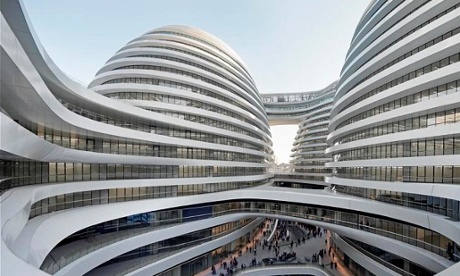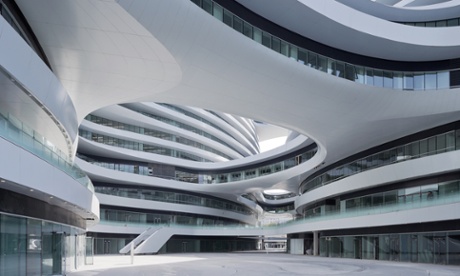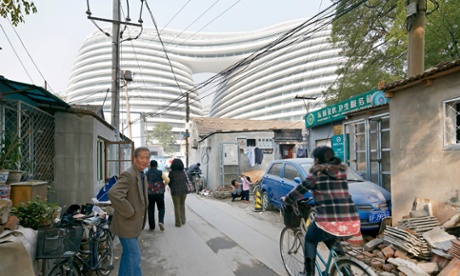- Joined
- Jul 23, 2012
- Messages
- 152
- Points
- 0
Zaha Hadid's mega mall accused of 'destroying' Beijing's heritage
The RIBA's decision to award a prize to the Galaxy Soho shopping centre has incensed Chinese preservation groups
Posted by
Oliver Wainwright
The Guardian
Friday 2 August 2013 12.55 BST

Alien arrival … the Galaxy Soho complex is accused of destroying Beijing's historic streets. Photograph: /Zaha Hadid Architects
Beijing's street names can be deceptive. Visitors to No 7A Small Arch hutong, just inside the city's second ring road, might get a little more than they bargained for. Long gone is the stone gateway that once marked the entrance to this network of narrow streets. Now, it's been replaced by a sinuous white arc, jacked 60m into the air, that loops and twists, connecting a cluster of vast egg-shaped buildings in an improbable acrobatic leap.
This alien arrival is Galaxy Soho, a 370,000 sq m complex of shops, offices and restaurants by Zaha Hadid Architects, recently bestowed with a top award by the Royal Institute of British Architects (RIBA). The judges heaped praise on its flowing bands of white aluminium and glass that “give the development an almost geological solidity and presence”. They hailed it as “a welcome democratisation” of the architect's work, asserting that the public space that weaves between the complex “demonstrates a rare generosity in a country determined to outdo the west in terms of commercialisation".
But others in Beijing beg to differ. The city's chief preservation watchdog has written an excoriating open letter to the RIBA accusing the project of “destroying” the city's built heritage, claiming that it has “violated a number of heritage preservation laws and regulations”.
The letter from the Beijing Cultural Heritage Protection Centre, published by Building Design this week, states that the project has “caused great damage to the preservation of the old Beijing streetscape, the original urban plan, the traditional hutong and courtyard houses, the landscape formation, and the style and colour scheme of Beijing’s unique vernacular architecture.”

The RIBA praised the building's public spaces as “a welcome democratisation” of the architect's work. Photograph: /Zaha Hadid Architects
The grass roots NGO, which has campaigned against the destruction of China's historic urban fabric for the last decade, also questioned the land acquisition process, claiming that the legal rights of the original residents were “grossly disregarded”. They said the RIBA's support of the project would exacerbate a growing trend of “corrupted officials” working hand-in-hand with developers to destroy the city.
“Many of us in Beijing are very disappointed and offended,” the letter said. “We sincerely wish that your institution would have a deeper understanding of the current situation in modern Chinese society, the severe challenges facing cultural heritage preservation in China, as well as the indecent conduct of many greedy developers. We strongly believe that this award will only encourage these developers and authorities to continue to commit the wrongs they have done and will increase the difficulties of cultural heritage preservation in China.”
The architects have been quick to distance themselves from the claims, alleging that the site had been cleared before they got involved. A spokesman for Zaha Hadid Architects said: “Throughout the design process, ZHA worked with the Local Design Institute (LDI) to ensure the project complies with all government building regulations and planning requirements. When ZHA was appointed to the project, no buildings existed on the site which is adjacent to large scale commercial/civic buildings and one of Beijing’s busiest motorways.”
When the complex opened in 2012, the latest in a series of mega-blocks that now march either side of the second ring road in a steel and glass gauntlet, Zaha Hadid explained that the design was inspired by the traditional spatial patterns of Beijing.
“We have created a variety of public spaces that directly engage with the city,” she said, “reinterpreting the traditional urban fabric and contemporary living patterns into a seamless urban landscape”. The interior courts, which swell and swirl as if the product of erosion, are apparently “a reflection of traditional Chinese architecture where courtyards create an internal world of continuous open spaces.”
Walking from the winding hutongs and dense siheyuan courtyard homes to the south of the site, into the flowing white world aboard the Galaxy – where armies of staff spend all day buffing up the aluminium to a gleaming sheen – it takes something of a leap of imagination to spot the connection.
As Hank Dittmar of the Prince's Foundation has said, “reflecting what was destroyed in the abstract, either formally as in Galaxy Soho’s courtyards, or through interpretation, is merely writing an obituary, not keeping the culture alive.”

Galaxy Soho looms in the background of neighbouring hutong streets. Photograph: Hufton + Crow/Zaha Hadid Architects
It is a trend enacted across the city, where centuries-old streets are flattened to make way for a Disneyfied incarnation of their former selves. The lanes of Nanchizi, beside the Unesco-listed Forbidden City, have been trampled by a complex of clubs and casinos, built with oversized courtyards and giant cartoon rooftops. The entire district of Qianmen, formerly a thriving commercial hub to the south of Tiananmen Square, has been recast as a themed heritage shopping zone, pumped-up steroidal shopfronts masking the mostly empty units behind.
Over the last 10 years, partly fuelled by the pre-Olympic gold rush, more than half of Beijing's old neighbourhoods have been demolished – and it is a fact not lost on the government. The former director of the State Administration of Cultural Heritage, Shan Jixiang, spoke out before leaving his post last year: “Bulldozers have razed many historical blocks,” he said. “Much traditional architecture that could have been passed down for generations as the most valuable memories of a city has been relentlessly torn down.” But these seem empty words from a man who presided over a decade of destruction.
Galaxy Soho has been shortlisted for the RIBA's Lubetkin Prize for the best international building – a gong won in 2009 by the Olympic Bird's Nest stadium, which was also complicit in sweeping away a whole chunk of old Beijing. If the Chinese government's own heritage department is in thrall to the construction boom, it rests with international institutions to call them out – rather than cheer on the violation of what little historic fabric the country has left.
